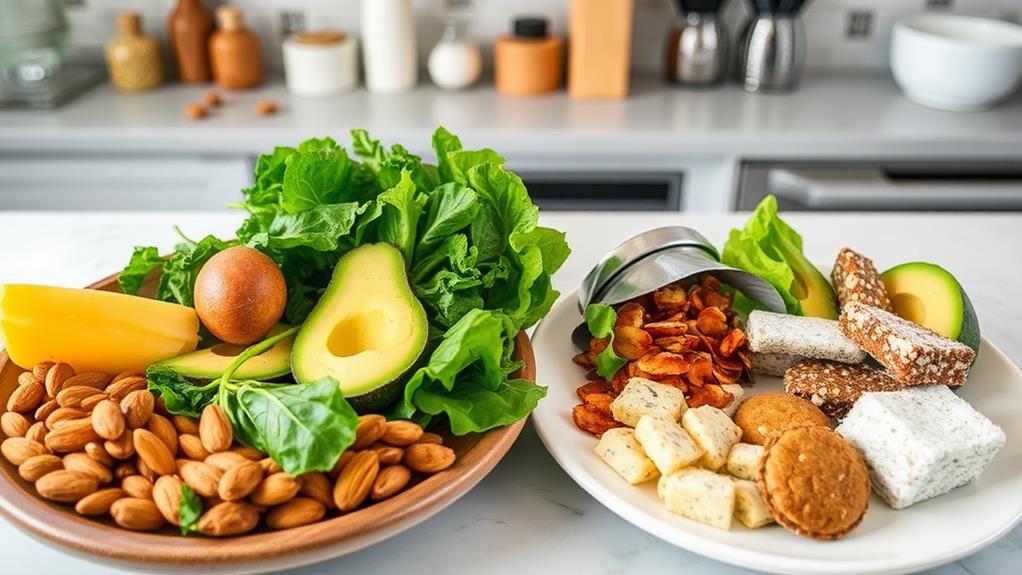As you prepare for the journey of childbirth, it's vital to equip yourself with knowledge and techniques that can facilitate a smooth normal delivery. From understanding the stages of labor to creating a flexible birth plan, there are 20 essential tips that can guide you through this experience. Incorporating effective exercises, like pelvic floor strengthening and gentle stretching, can further enhance your comfort. Curious about how these strategies can empower you and what specific exercises to include in your routine? Let's explore these valuable insights together.
Stay Informed About Labor
Staying informed about labor is essential for your peace of mind and preparation. When you know what to expect, it can make the whole experience a lot less scary. You'll want to read books, attend classes, and ask questions to get a good grasp on the process. Remember, knowledge is power!
You might be surprised to learn that labor doesn't always go as planned. It can be like a roller coaster ride—full of twists, turns, and unexpected surprises. By understanding the stages of labor, you can feel more in control.
Don't forget to talk to your healthcare provider about what you can expect. They're there to help you navigate this exciting journey!
Also, consider joining a support group or finding a buddy who's been through labor before. Sharing stories can ease fears and boost your confidence. Plus, a good laugh can lighten the mood during those tense moments.
Lastly, keep in mind that every labor experience is unique. So, stay flexible and be ready for anything. With the right information, you'll be prepared to tackle whatever comes your way, making your delivery a smoother experience!
Choose the Right Birth Plan
When planning for your delivery, choosing the right birth plan is essential for ensuring a positive experience. Think of your birth plan as a roadmap for your big day. It's your chance to express how you'd like things to go. You can include your preferences for pain management, who you want in the room, and any specific positions you'd like to try during labor.
Don't be afraid to get creative! If you want soothing music or a certain scent, jot that down.
Also, remember that flexibility is key. Sometimes, things don't go as planned, and that's okay! Be open to changes, and keep in mind that your healthcare team is there to support you.
Discuss your birth plan with your doctor or midwife. They can offer valuable insights and help you understand what's realistic based on your health and pregnancy. It's important to feel comfortable with your choices, so ask questions if you're unsure.
In the end, what matters most is your comfort and well-being. So, grab a pen, get brainstorming, and make your birth plan reflect what you truly want.
After all, this is your journey into motherhood!
Attend Prenatal Classes
After you've crafted your birth plan, attending prenatal classes can greatly enhance your preparation for delivery.
These classes offer a treasure trove of information, making them a must for expectant parents. You'll learn about the stages of labor, pain management options, and what to expect during your hospital stay. Plus, it's a great chance to meet other parents-to-be who are just as excited—and nervous—as you are!
During these classes, you'll get hands-on practice with breathing techniques and even some essential baby care skills. Imagine learning how to change a diaper before the big day! It can feel overwhelming, but the more you know, the more confident you'll become.
Don't worry if you feel a little shy. Everyone's in the same boat, and the instructors are there to help you feel comfortable.
You might even find yourself sharing a laugh about the joys—and challenges—of pregnancy.
Practice Relaxation Techniques
Relaxation techniques can be your best friend as you prepare for a smooth normal delivery. You might be wondering how to calm those butterflies fluttering in your stomach. Well, techniques like deep breathing, visualization, and gentle stretches can help you feel more at ease.
Start with deep breathing. It's simple—just inhale slowly through your nose, hold it for a moment, and then exhale through your mouth. It's like giving your body a mini-vacation!
Visualization is another fantastic tool. Picture yourself in a peaceful place, maybe a sunny beach or a cozy garden. This can help your mind focus and reduce anxiety.
Don't forget about gentle stretching! Stretching helps relieve tension and can make you feel more comfortable. You can even try some light yoga poses. The best part? You can do all these techniques almost anywhere!
Maintain a Balanced Diet
Staying calm and focused can set the stage for a smoother delivery, but don't overlook the power of nutrition. What you eat plays a huge role in how you feel during pregnancy and can impact your delivery experience. So, let's talk about maintaining a balanced diet!
You'll want to fill your plate with a mix of fruits, veggies, whole grains, and lean proteins. Think of it as fueling up for the big race—your body needs the right energy to keep going.
Foods rich in iron, like spinach and beans, will help prevent anemia, while calcium from dairy products builds strong bones for you and your baby.
Don't forget healthy fats, too! Nuts, avocados, and olive oil keep your energy levels up and can even help with mood swings.
And while it might be tempting to indulge in every craving, try to keep junk food at bay. Your body will thank you later!
Stay Hydrated
To guarantee a smooth delivery, keeping hydrated is essential. Water isn't just a drink; it's your best friend during pregnancy. When you're well-hydrated, your body functions better, and you'll feel more energized. Plus, staying hydrated helps prevent pesky issues like swelling and constipation.
So, how much water do you need? Aim for about 8-10 glasses a day. Sounds like a lot? Just carry a water bottle with you everywhere. You'll be surprised how quickly you can sip your way to hydration! If plain water feels a little boring, try adding some slices of lemon or cucumber for a revitalizing twist.
Don't forget, you can also hydrate with fruits and veggies! Watermelon, oranges, and cucumbers aren't only tasty but also pack a hydration punch.
When you feel thirsty, drink up! Listen to your body—it's usually pretty good at telling you what it needs.
Prepare for Labor Pain
As you gear up for labor, preparing for the pain can make a world of difference. Understanding what to expect is key. Labor pain can feel like intense cramps or pressure, sometimes compared to really strong menstrual pain. But don't worry, you've got options!
First, consider practicing breathing techniques. Deep, slow breaths can help you stay calm, and they're a great way to focus your mind. You might even want to try visualization. Picture a peaceful place, like a sunny beach, while you breathe through the contractions. It's like a mini-vacation in your head!
Next, you can explore different positions during labor. Walking, swaying, or using a birthing ball can help ease the discomfort. Movement can be your best friend!
Also, think about using heat. A warm compress on your back or a warm shower can be soothing. It's like giving yourself a little spa treatment while you work hard to meet your baby.
Consider Continuous Support
Having a solid support system during labor can greatly enhance your experience and help manage pain. It's like having your own cheer squad, ready to lift your spirits. Whether it's your partner, a family member, or a close friend, having someone by your side makes a huge difference. They can offer comforting words, hold your hand, and remind you to breathe.
Think about what kind of support you'd want. Do you prefer someone who cracks jokes to lighten the mood, or someone who stays quiet and just holds your hand? It's important to choose someone who fits your style. You want them to know how to help you, whether it's with gentle massages or simply being a calming presence.
Also, let your support person know your birth plan and preferences. This way, they can advocate for you and make decisions if needed. Continuous support doesn't just help with pain; it can also help you feel more secure and confident.
Use Visualization Techniques
Using visualization techniques can be a powerful tool during labor, helping you focus your mind and ease anxiety. Imagine this: you're in your special place, maybe a beach or a cozy room. You might see yourself relaxing and breathing deeply, feeling calm and in control. This image can help you feel more confident during labor.
As you start to feel contractions, visualize each one as a wave rolling in and then gently rolling back out. Imagine the wave bringing your baby closer to you, then receding with each breath. You can even visualize a warm light surrounding you, offering comfort and strength. This can be a great way to stay positive and focused.
When your thoughts start to wander or worry creeps in, gently bring your mind back to your chosen image. It's okay to have those feelings, but remember, you're a team with your body and your baby.
Engage in Light Exercise
Engaging in light exercise during pregnancy can bring a sense of importance and well-being. It's not just about staying fit; it's about feeling great!
Walking, swimming, and gentle stretching can help you stay active and boost your mood. Plus, these activities can ease some of those pesky pregnancy aches and pains.
You don't have to run a marathon or lift heavy weights—simple moves are perfect. A brisk walk around your neighborhood can do wonders for your energy levels. If you fancy a splash, swimming is fantastic for your body. The water supports you, making it feel like you're floating on a cloud!
Consider joining a prenatal yoga class, too. It's a fun way to meet other moms-to-be while learning to relax and breathe deeply.
Just remember to listen to your body. If something feels uncomfortable, it's okay to slow down or take a break.
Monitor Your Baby's Movements
Staying active not only benefits you but also plays a role in monitoring your baby's movements. When you're moving around, you might notice those little kicks and wiggles more easily. It's like a dance party in your belly, and you're the DJ!
Keeping track of your baby's movements can help you feel more connected and aware of how they're doing. To monitor their movements, try counting kicks. You can pick a time when your baby is usually active, like after you eat or when you relax.
Ideally, you should feel at least ten movements within two hours. If you notice a significant decrease in activity, don't hesitate to reach out to your healthcare provider. They're there to help you, and it's always better to be safe!
You might also find that certain positions or gentle movements can encourage your baby to move more. So, get comfy, put on some calming music, and enjoy this special time together.
Create a Comfortable Birth Environment
Creating a comfortable birth environment is essential for a positive labor experience, as it helps you feel more at ease and in control. You can start by choosing a space that feels cozy and familiar. Whether it's at home or in a hospital, make sure it's a place where you can relax.
Bring items that make you happy, like soft pillows, your favorite blanket, or even a few photos of loved ones. These little touches can create a warm atmosphere.
Lighting is another important factor. Dim lights can help set a calming mood, so consider bringing a nightlight or using the room's curtains to block out harsh lights.
Don't forget about sounds, too! Play soothing music or nature sounds that you enjoy. You might even want to bring a speaker if you have a playlist ready.
Lastly, try to keep the temperature comfortable. If you're feeling too hot or too cold, it can make things more stressful. So, ask for a fan, or grab a cozy blanket if you need one.
With these adjustments, you're on your way to creating a space that feels just right for welcoming your little one into the world!
Communicate With Your Healthcare Team
Open lines of communication with your healthcare team can greatly enhance your birthing experience. When you're feeling nervous or excited, it's important to share your thoughts and questions. Don't hesitate—ask about everything! Whether it's about pain management or the process of labor, your team is there to help you understand.
Make sure to discuss your birth plan, too. This is your chance to express your wishes and preferences. Let them know what you want, whether it's a quiet environment or certain positions you'd like to try. Your team can tailor your care to fit your needs.
Also, be open to their advice. They've seen it all, and their expertise can guide you through unexpected moments. If something feels off or you're uncomfortable, speak up! Your feelings matter, and clear communication can help everyone stay on the same page.
Practice Breathing Exercises
As you prepare for labor, practicing breathing exercises can greatly ease your anxiety and help manage pain during contractions.
It's like giving your body a secret tool to handle the big day! Start by finding a comfortable position, whether sitting or lying down. Take a deep breath in through your nose, letting your belly rise, and then slowly breathe out through your mouth. You might feel like you're blowing out birthday candles, but that's okay!
Try to practice this for a few minutes each day. As you get used to it, you can add counting to your breaths. Inhale for a count of four, hold for four, and exhale for six.
This helps create a rhythm, which can feel super calming.
Explore Pain Relief Options
While breathing exercises can help you manage anxiety and pain, exploring various pain relief options is also important for your comfort during labor. You've got some choices, and knowing them can make a big difference!
First, there's the classic epidural. It delivers medication directly into your spine, helping numb the pain. Some women love it, while others prefer to feel more in control.
You might also consider nitrous oxide, known as laughing gas. It's not just for dental visits! It can help you relax and take the edge off without completely dulling your senses.
Don't forget about natural methods too! Massage, warm baths, or even using a birthing ball can ease discomfort. Sometimes, a simple change in position can work wonders!
If you're feeling adventurous, you could explore acupressure or aromatherapy. Those little touches can help create a calm environment, which is key during labor.
Whatever you choose, remember that it's all about what feels right for you. So, talk to your healthcare provider about your options, and don't hesitate to ask questions. You've got this!
Focus on Positive Affirmations
Positive affirmations can be a powerful tool during labor, helping to cultivate a mindset of strength and confidence. When you repeat positive statements like "I am strong" or "I can do this," you're training your brain to focus on the good stuff instead of the scary parts. It's like giving yourself a pep talk before a big game!
Try writing down a few affirmations that resonate with you. You can stick them on your fridge, your bathroom mirror, or even on your birth plan. This way, you'll see them often, and they'll become part of your routine.
When you feel those contractions coming, take a deep breath and say your affirmations out loud. You might even want to say them to your partner or support team, so they can join in and help lift your spirits.
Stay Active During Pregnancy
Staying active during pregnancy is essential for both your physical and mental well-being. It's like giving yourself a little boost every day! Regular exercise can help keep your energy levels up, reduce stress, and even improve your mood. Plus, it can make those late-night cravings a bit easier to handle!
You don't need to run marathons or lift heavy weights. Simple activities like walking, swimming, or prenatal yoga can work wonders. Aim for at least 30 minutes of moderate exercise most days of the week. It's fun, it's healthy, and it helps you connect with your growing baby. Just think of it as a special time you set aside for both of you!
Listen to your body, though. If something doesn't feel right, it's okay to slow down or switch activities. Remember, you're not training for the Olympics!
And don't forget to stay hydrated and wear comfy shoes—your feet will thank you.
Staying active isn't just about physical fitness; it's also about feeling good mentally. So, get moving and enjoy this amazing journey. You've got this!
Prepare for Postpartum Care
Preparing for postpartum care is essential, as it sets the foundation for your recovery and well-being after childbirth. The first step is to gather your supplies. Stock up on items like pads, comfy underwear, and any medications your doctor recommends. Trust me, the right gear can make all the difference!
Next, consider your meals. You'll want nutritious snacks and easy-to-prepare meals. Think smoothies, frozen veggies, or meals that your loving friends and family can whip up for you. It's okay to accept help; you're not a superhero yet!
Don't forget to create a cozy space for yourself. Whether it's a comfy chair for feeding or a soft blanket to snuggle under, having a little sanctuary will help you relax.
Lastly, remember to take it easy. Your body's been through a lot, and it needs time to heal. Don't be afraid to ask for support or share your feelings.
Involve Your Partner
How can you guarantee a smoother delivery experience? One of the best ways is to involve your partner in the process. When both of you're on the same page, it can make a world of difference.
Start by discussing your birth plan together. Share your hopes, fears, and preferences. This helps your partner understand what you need during labor.
Your partner can play a crucial role in providing support. They can help with breathing techniques, massage your back, or even hold your hand during contractions. Having someone you trust by your side can ease anxiety.
Plus, it's nice to have a cheerleader reminding you how amazing you are!
Don't forget to practice the exercises together. Not only does this prepare you both physically, but it also strengthens your bond.
You might even find some laughs along the way.
Trust Your Body's Instincts
Trusting your body's instincts is essential for a smoother delivery. Your body knows what to do, even when you might feel nervous or unsure. When labor begins, you'll probably feel some strong sensations. Instead of fighting those feelings, embrace them! Your body is like a superhero, and it's working hard to bring your baby into the world.
Listen closely to what your body tells you. If you feel the urge to move, stretch, or change positions, go for it! Swaying your hips or finding a comfy spot can really help. Remember, this isn't a race; it's a journey. Take deep breaths and relax whenever you can. Each contraction brings you one step closer to meeting your little one.
Sometimes, you might doubt yourself, but that's totally normal. Think of it as your body's way of saying, "I got this!" Surround yourself with supportive people who believe in you, too. They can lift your spirits and remind you of your strength.























































